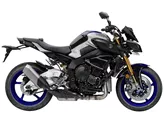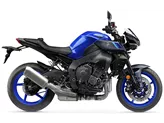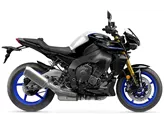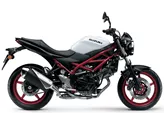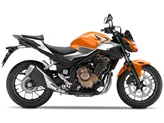Suzuki SV 650 2017 vs. Yamaha MT-10 SP 2019

Suzuki SV 650 2017

Yamaha MT-10 SP 2019
Overview - Suzuki SV 650 2017 vs Yamaha MT-10 SP 2019
The Suzuki SV 650 2017 and the Yamaha MT-10 SP 2019 are both naked bikes that offer a thrilling riding experience. However, there are notable differences between the two models.
In terms of engine performance, the Yamaha MT-10 SP 2019 takes the lead with its powerful 160 HP engine, compared to the Suzuki SV 650 2017's 76 HP engine. The Yamaha also boasts a higher torque of 111 Nm, while the Suzuki offers 64 Nm. Both bikes feature fuel injection systems and liquid cooling.
When it comes to suspension, both bikes have swing arm rear suspensions with monoshock absorbers. However, the Yamaha MT-10 SP 2019 has an upside-down telescopic fork front suspension, which provides better handling and stability compared to the Suzuki SV 650 2017's telescopic fork. Additionally, the Yamaha's rear suspension is made of aluminum, while the Suzuki's is made of steel.

Suzuki SV 650 2017
In terms of chassis, the Yamaha MT-10 SP 2019 features an aluminum frame, specifically a Deltabox frame, which is known for its rigidity and lightweight construction. On the other hand, the Suzuki SV 650 2017 has a steel tubular frame. The Yamaha's chassis design offers better handling and maneuverability.
Both bikes have double disk front brakes, but the Yamaha MT-10 SP 2019 has larger 320 mm diameter disks, providing better stopping power compared to the Suzuki SV 650 2017's 290 mm disks. Both models also feature ABS for advanced rider assistance.

Yamaha MT-10 SP 2019
In terms of dimensions and weights, the Yamaha MT-10 SP 2019 has a wider rear tire with a width of 190 mm, compared to the Suzuki SV 650 2017's 160 mm rear tire. The Yamaha also has a larger fuel tank capacity of 17 liters, while the Suzuki's capacity is 13.8 liters. The Yamaha is slightly heavier with a kerb weight of 210 kg, compared to the Suzuki's 197 kg.
Both bikes offer comfortable seating positions, but the Yamaha MT-10 SP 2019 provides better wind protection. It also offers additional features such as suspension electronically adjustable, riding modes, ride by wire, and traction control, which are not available on the Suzuki SV 650 2017. However, the Yamaha's traction control does not have a gyro sensor, which may be a drawback for serious racetrack use. The Yamaha also has a higher price compared to the Suzuki.
In summary, the Yamaha MT-10 SP 2019 offers a more powerful engine, better suspension, advanced rider assistance systems, and additional features compared to the Suzuki SV 650 2017. However, the Suzuki provides a smooth engine, playful handling, and a great chassis. Both bikes have their strengths and weaknesses, and the choice between them ultimately depends on the rider's preferences and priorities.
Technical Specifications Suzuki SV 650 2017 compared to Yamaha MT-10 SP 2019
Pros and Cons in comparison
Pros and Cons in comparison
Suzuki SV 650 2017

The Suzuki SV 650 is accompanied by a long history of success that is sure to continue for a long time. Its supple V2 impresses with very smooth response and plenty of torque. Compact dimensions help to make the motorbike look very compact. This will be very convenient for beginners. The chassis also scores with playful handling. Unfortunately, the braking effect is not at the level one would expect from such a powerful vehicle.
Yamaha MT-10 SP 2019

The Yamaha MT-10 SP inspires with a high degree of perfection combined with a truckload of emotion. Rarely do Japanese manufacturers succeed in penetrating so deeply into the domain of Europeans. The bike rides very nastily when needed, but can also be used quite civilly in city traffic. On top of that, the electronically adjustable Öhlins suspension offers a lot of riding comfort. All in all, an outstanding all-rounder that can do much more than just look bad.
Price Comparison Avarage Market Price Suzuki SV 650 vs Yamaha MT-10 SP
There are a few key differences between a Suzuki SV 650 2017 and a Yamaha MT-10 SP 2019. There are the same number of bikes of both models available on the 1000PS.de marketplace, specifically 6. It takes less time to sell a Yamaha MT-10 SP with 92 days compared to 112 days for the Suzuki SV 650. Since model year 2005 1000PS.de editors have written 25 reviews for the Suzuki SV 650 and 18 reviews for the Yamaha MT-10 SP since model year 2017. The first review for the Suzuki SV 650 was published on 26/09/2008 and now has more than 14,200 views. This compares to more than 28,600 views for the first review on Yamaha MT-10 SP published on 04/10/2016.







